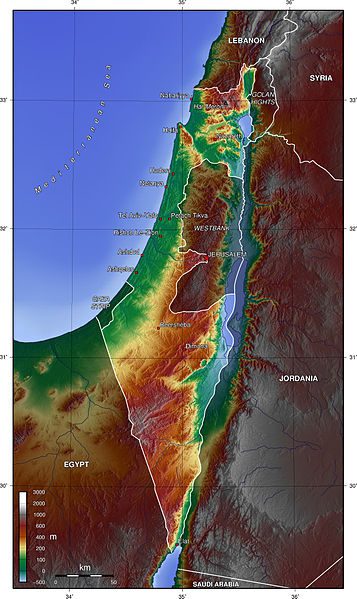
Israel/Palestine is essentially a mountain ridge, flanked on the West by a coastal plain going down to the Mediterranean Sea and, on the East, by a steep decline into the Jordan Rift Valley (a northern continuation of Africa’s Great Rift Valley), which is the deepest gash into Earth’s crust anywhere on the planet. (The Dead Sea lies 1407 feet below the surface of the Mediterranean.) Jerusalem sits high on the mountain ridge; the altitude of the Old City is roughly 2500 feet, with Mount Scopus and the Mount of Olives looming still higher above it.
Of the many things that could be said about 1 Nephi 5, I choose to focus, today at least, on up and down.
In 1 Nephi 5:1, Nephi and his brothers come “down” from Jerusalem to the “wilderness” where his parents, Lehi and Sariah, anxiously await their return. (Cf. 1 Nephi 5:5.)
In 1 Nephi 5:6, they’re described as having gone “up” to “the land of Jerusalem.”
Throughout these chapters, while the Lehite party is still in the vicinity of Jerusalem, this sort of language is very consistently used. They go “up” to the city and come “down” from it.
This is significant.
Psalms 120-134 in the Hebrew Bible are commonly referred to as “songs of ascent” or “songs of degrees” (שִׁיר המַעֲלוֹת). It’s thought by many scholars that they may have been sung by pilgrims who were climbing up the road to Jerusalem during major feasts, or even by priests who were ascending the fifteen steps of the Jerusalem Temple for their liturgical service.
Even today, עֲלִיָּה (aliyah), or “ascent,” is the term used for the immigration of diaspora Jews from other countries to “the land of Israel” (Eretz Yisrael), as well as, more specifically, “the act of going up” or traveling towards Jerusalem. (It’s one of the most basic tenets of modern Zionism.) The opposite action, emigration from Israel/Jerusalem, is referred to as yerida, or “descent.”
Jerusalem sits on the crest of the Judean hills, at more than 2500 feet above sea level. It’s not the highest peak in the Middle East, nor even in its immediate environment, but it’s fairly isolated on three sides and it’s fairly impressive. Just thirty-two miles to the west is the Mediterranean Sea, which is . . . well, at sea level. Thirteen miles to the east is the Dead Sea — which, at more than 1400 feet below sea level, is the lowest point on the planet other than the depths of the ocean itself. Anybody who has ever driven the grade from Jericho up to Jerusalem knows that road to be a very slow haul, in low gear.
There is reason behind Isaiah’s depiction of “the last days,” in which “the mountain of the Lord’s house shall be established in the top of the mountains, and shall be exalted above the hills; and all nations shall flow unto it” (2:2).
And Nephi’s description of going up to Jerusalem, and of coming down from Jerusalem, accords very neatly with the reality of the place.











